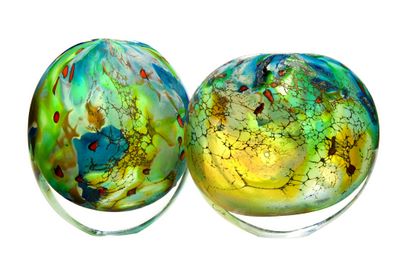
An introduction to the London glassblowing studio
The London Glassblowing studio is aptly situated in the heart of a developing arts locale about ten minutes walk from London Bridge Station.
Opened by Peter Layton in 1976 it is now one of Europe’s renowned centres for making and displaying works by leading artists. What’s interesting is that the studio is combines a working factory and shop display area both of which are accessible to the general public.
1 Glassblowing is a technique that involves inflating molten glass into a bubble, or parison, with the aid of a blowpipe or blow tube. A person who blows glass is called a glassblower, glassmith, or gaffer. Early records indicate glassblowing existed as far back as 50 BC along the Syro Palestinian coast.
Two methods of glassblowing are largely employed today. Free blowing (blowing air down a blowpipe into the molten glass globule) and mould blowing (where a glass globule is blown into a preformed mould). Free blowing relies on the skill of the blower to produce a uniform product whereas mould blowing allows forms to be produced consistently on a mass scale.
As well as professional training programmes for students of Fine Art and related subjects, the London Glassblowing Studio offers the general public practical courses of one to two hours duration each. After a safety induction (the glassblowing area is a mass of kilns and ovens), one is shown how to gather molten glass from the furnace with a dipping rod, manipulate the molten globule, add colour particles and eventually produce an aesthetically shaped object such as a paperweight. There are seven classes in all with subsequent lessons making a greater demand on the student’s skills.
Some interesting points to note:-
The working temperature of glass is 1100 degrees centigrade and blown glass typically take thirty six hours to return to room temperature. Cooling is achieved by means of an annealing oven which allows the glass to cool slowly.
Colours are introduced to the molten globule by dipping and rolling in chips or powder. It is practice to roll the globule in the coarser ‘cut’ colours first. After the stresses of burning and cooling, the end colour(s) achieved may be completely different from their original shade(s).
Dipping the globule periodically in the glory hole (reheating chamber) keeps the glass molten and moving during the glassblowing process.
Interesting effects such as entrained air bubbles can be achieved by pricking the surface of the glass with tongs as the globule is being shaped. For more information including a list of future exhibitions, commissioned artists and guide to glassblowing equipment seewww.thelondonglassblowingstudio.org
1 courtesy of Wikipedia online encyclopaedia.






Pingback: take me down
Pingback: Geary Group
Pingback: dont approve me